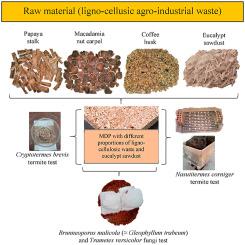当前位置:
X-MOL 学术
›
Int. Biodeterior. Biodegrad.
›
论文详情
Our official English website, www.x-mol.net, welcomes your
feedback! (Note: you will need to create a separate account there.)
Resistance of particleboards produced with ligno-cellulosic agro-industrial wastes to fungi and termites
International Biodeterioration & Biodegradation ( IF 4.1 ) Pub Date : 2021-02-01 , DOI: 10.1016/j.ibiod.2020.105159 Fabricio Gomes Gonçalves , Juarez Benigno Paes , Yonny Martinez Lopez , Pedro Gutemberg de Alcântara Segundinho , Rafael Gonçalves Espósito de Oliveira , Michelângelo Vargas Fassarella , Alice Soares Brito , Izabella Luzia Silva Chaves , Rhagnya Sharon Ferreira Martins
International Biodeterioration & Biodegradation ( IF 4.1 ) Pub Date : 2021-02-01 , DOI: 10.1016/j.ibiod.2020.105159 Fabricio Gomes Gonçalves , Juarez Benigno Paes , Yonny Martinez Lopez , Pedro Gutemberg de Alcântara Segundinho , Rafael Gonçalves Espósito de Oliveira , Michelângelo Vargas Fassarella , Alice Soares Brito , Izabella Luzia Silva Chaves , Rhagnya Sharon Ferreira Martins

|
Abstract This study aimed to evaluate the resistance of medium density particleboard (MDP) made with ligno-cellulosic agro-industrial wastes to Brunneoporus malicola (≈Gleophyllum trabeum) and Trametes versicolor fungi and Cryptotermes brevis and Nasutitermes corniger termites. The panels were produced by compression, with different proportions of eucalypt sawdust, macadamia nut carpel, papaya stalk and coffee husks (10%, 20% and 30% each one and the control - 100% eucalypt sawdust) and bonded with urea-formaldehyde (UF) and tannin-urea-formaldehyde (TUF). The fungi and termite tests were performed in conformity the specific standards of wood and wood-based materials biological resistance. The resistance of each treatment was evaluated in terms of the composite mass loss and mortality for termite. All treatments submitted to the attack of Brunneoporus malicola and Tramites versicolor fungi were classified as moderately resistant or no resistant, no statistical difference. Highlight for 30% macadamia nut carpel with less mass loss, 42.28% and 43.58% in the UF and TUF panels, respectively. There were no statistical differences for mass loss and mortality between treatments and adhesives to dry-wood termites; treatment with 10% and 30% macadamia nut carpel showed greater mass loss (0.681 g) and mortality (56.50%), respectively. In general, all treatments showed low resistance to fungi and for dry-wood termite attack good resistance, indicating these case biological properties of the panels. The panels produced did not allow resistance to attack of Nasutitermes corniger termite.
中文翻译:

用木质纤维素农业工业废料生产的刨花板对真菌和白蚁的抵抗力
摘要 本研究旨在评估由木质纤维素农业工业废料制成的中密度刨花板 (MDP) 对 Brunneoporus malicola (≈Gleophyllum trabeum) 和 Trametes versicolor 真菌以及 Cryptotermes brevis 和 Nasutitermes corniger 白蚁的抵抗力。这些面板是通过压缩生产的,用不同比例的桉树锯末、澳洲坚果心皮、木瓜茎和咖啡壳(10%、20% 和 30% 各一种,对照 - 100% 桉树锯末)并用尿素甲醛粘合( UF) 和单宁-脲-甲醛 (TUF)。真菌和白蚁测试符合木材和木质材料生物抗性的特定标准。根据白蚁的复合质量损失和死亡率来评估每种处理的抵抗力。所有受Brunneoporus malicola和Tramites versicolor真菌侵袭的处理均分为中等抗性或无抗性,无统计学差异。突出显示 30% 澳洲坚果心皮质量损失较少,UF 和 TUF 面板中的质量损失分别为 42.28% 和 43.58%。处理和粘合剂对干木白蚁的质量损失和死亡率没有统计学差异;用 10% 和 30% 澳洲坚果心皮处理分别显示出更大的质量损失 (0.681 g) 和死亡率 (56.50%)。一般而言,所有处理都显示出对真菌的低抵抗力和对干木白蚁攻击的良好抵抗力,表明这些情况下面板的生物特性。生产的面板不能抵抗 Nasutitermes Corniger 白蚁的攻击。
更新日期:2021-02-01
中文翻译:

用木质纤维素农业工业废料生产的刨花板对真菌和白蚁的抵抗力
摘要 本研究旨在评估由木质纤维素农业工业废料制成的中密度刨花板 (MDP) 对 Brunneoporus malicola (≈Gleophyllum trabeum) 和 Trametes versicolor 真菌以及 Cryptotermes brevis 和 Nasutitermes corniger 白蚁的抵抗力。这些面板是通过压缩生产的,用不同比例的桉树锯末、澳洲坚果心皮、木瓜茎和咖啡壳(10%、20% 和 30% 各一种,对照 - 100% 桉树锯末)并用尿素甲醛粘合( UF) 和单宁-脲-甲醛 (TUF)。真菌和白蚁测试符合木材和木质材料生物抗性的特定标准。根据白蚁的复合质量损失和死亡率来评估每种处理的抵抗力。所有受Brunneoporus malicola和Tramites versicolor真菌侵袭的处理均分为中等抗性或无抗性,无统计学差异。突出显示 30% 澳洲坚果心皮质量损失较少,UF 和 TUF 面板中的质量损失分别为 42.28% 和 43.58%。处理和粘合剂对干木白蚁的质量损失和死亡率没有统计学差异;用 10% 和 30% 澳洲坚果心皮处理分别显示出更大的质量损失 (0.681 g) 和死亡率 (56.50%)。一般而言,所有处理都显示出对真菌的低抵抗力和对干木白蚁攻击的良好抵抗力,表明这些情况下面板的生物特性。生产的面板不能抵抗 Nasutitermes Corniger 白蚁的攻击。











































 京公网安备 11010802027423号
京公网安备 11010802027423号